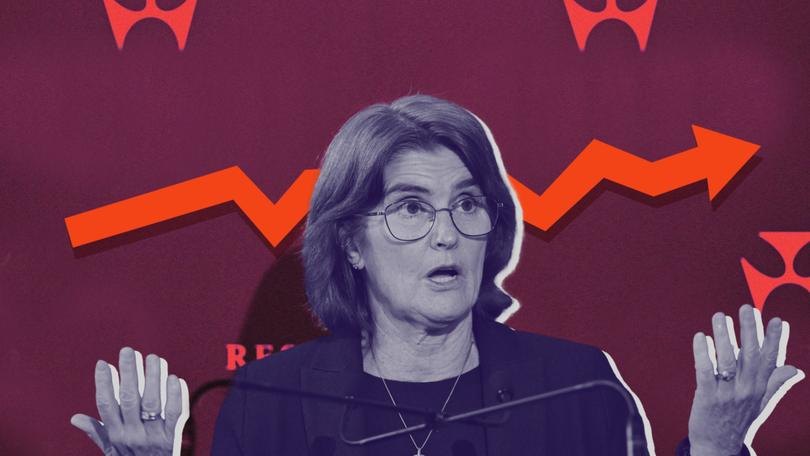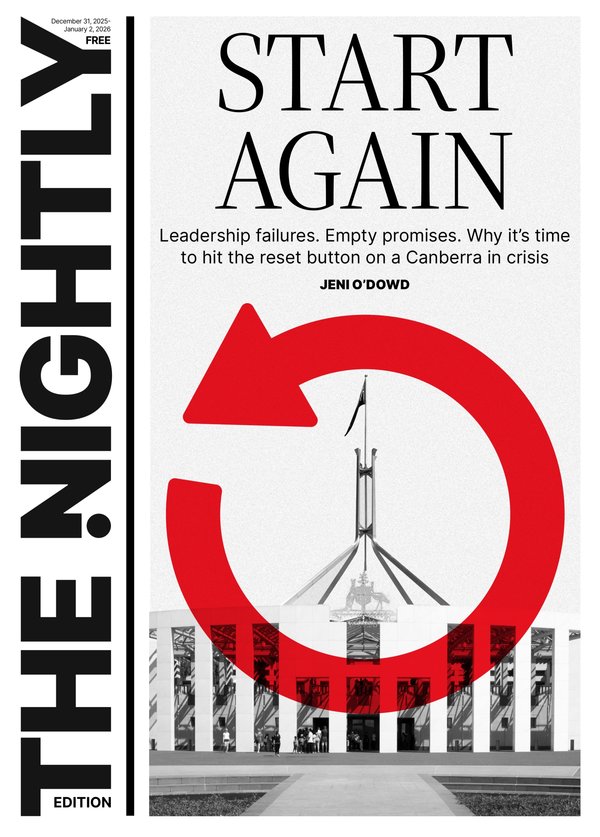Interest rates: Reserve Bank of Australia says it’ll be six months before a cut. Here’s why it could be sooner

Days ago, at the start of last week, there was talk of a Reserve Bank rate hike.
Not now, not seriously, although Reserve Bank Governor Michele Bullock said it remained an option on the table when her board met on Tuesday.
In the United States, there’s talk of a double cut — two standard-size rate cuts at once — in a bid to stave off recession when the US Fed next meets next month. US markets are pricing in five standard size cuts in the next four months.
Sign up to The Nightly's newsletters.
Get the first look at the digital newspaper, curated daily stories and breaking headlines delivered to your inbox.
By continuing you agree to our Terms and Privacy Policy.In Australia, those arguing that inflation would force our Reserve Bank to push up rates this year have lost one of the planks on which their argument depended.
So despite what the Reserve Bank governor said on Tuesday, here’s why so many people expect interest rates will have to come down — possibly sooner than the governor suggests.
Inflation to fall, bounce and fall again
After announcing on Tuesday it had decided to keep the cash rate on hold at 4.35 per cent this month, the bank updated its forecasts. It’s now expecting inflation to return to its target band by Christmas.
Australia’s inflation rate began the year at 4.1 per cent. It was 3.6 per cent by March, then 3.8 per cent in June, and will be 3 per cent — back to the edge of the Reserve Bank’s 2-3 per cent target band — by December, according to the updated forecasts.
Much of the decline in measured inflation will be due to two measures announced in May’s Federal Budget: energy price relief of $300 per household, and a 10 per cent increase in Commonwealth Rent Assistance. The Reserve Bank says their combined effect will be to take 0.60 points off measured inflation.
After the energy price relief ends midway through 2025, the Reserve Bank expects inflation to bounce back up above the target — but only temporarily — before falling back towards it from late 2025.
It expects its preferred measure of underlying inflation, called the “trimmed mean”, to continue to fall, as it has since late 2022.
Bullock said she is not yet confident inflation is moving “sustainably” towards the target band. She said the bank was unlikely to cut rates in the “near term”, which she said meant this year or early next year.
But many think the bank will have to cut rates well before inflation is where it wants it — and here’s why.
The risk of waiting too long
Changes to interest rates take a while to work their way through the economy — as much as a year, and on some estimates as much as two years.
The bank believes that where rates are right now is “restrictive” — meaning at their current level, rates are weighing down on spending and prices.
If it continued to keep rates where they are, and waited until inflation was well within the centre of its target band before it eased, it’d overshoot and push inflation below the band. That would damage the economy for no good reason.
At Tuesday’s press conference, Bullock conceded that her talk about no near-term cut was at odds with the expectations of financial markets, and was “not what people want to hear”.
But the weight of betting on those markets has become overwhelming.
At 5pm on Monday — ahead of Tuesday’s Reserve Bank board meeting — the futures market had more than fully priced in a cut of 0.25 points in the bank’s cash rate by November. It had priced in a further cut by February, and another by April, making a total of three before the due date for the federal election in May.
The first cut would save a variable-rate borrower with a $600,000 mortgage $90 per month. The three cuts combined would save $275.
What has changed traders’ expectations? What’s happening in the United States.
A US recession is more likely
On Friday, the US unemployment rate climbed for the fourth month in a row. The increase, from 4.1 per cent to 4.3 per cent, was enough to fulfil the requirements of what’s known as the Sahm Rule, which is said to have predicted every US recession.
That doesn’t necessarily mean there will be a recession. But the creator of the rule, former US economist Claudia Sahm, says the risk has “really gone up.”
On the back of the news, US shares dived 3 per cent on Friday. On Monday, Australian shares dived 3 per cent, wiping out most of their gains this year.
In Japan, share prices plunged 12 per cent, in part because, alone among major industrial nations, Japan had actually increased its official interest rate.
On Tuesday, share markets recovered a bit — and Japan’s recovered a lot. But traders remain skittish. The risk of a recession and all that it entails, including Americans losing jobs and economic growth collapsing, is growing.
How a US recession would hit Australia
As it happens, Australia’s Reserve Bank has examined what a US recession would do to conditions in Australia.
A set of studies released under freedom of information rules conclude the direct effects would be limited, as Australia earns much of its money from China. But those effects would be amplified by a hit to consumer confidence and greater financial market uncertainty, which would make it harder for businesses to borrow.
After a year or so, Australia’s gross domestic product (GDP) would be 0.5 per cent lower than it would have been.
Given Australia’s economy barely grew at all in the first three months of this year, that could be enough to push Australia into a recession as well.
We’re already in a personal recession
In its report released on Tuesday, the Reserve Bank makes the point that individual Australians are already in a recession. It says GDP per capita (income per person) has fallen 1.6 per cent since mid-2022.
It also acknowledges that the European Central Bank, the Bank of Canada, the Bank of England and Sweden’s Riksbank have all cut rates in response to lower inflation — and that New Zealand’s Reserve Bank and the US Fed are preparing to.
Peter Martin, Visiting Fellow, Crawford School of Public Policy, Australian National University
This article is republished from The Conversation under a Creative Commons license. Read the original article.
